Wenhu line
The Wenhu or Brown line (code BR) is a metro line in Taipei operated by Taipei Metro, named after the districts it connects: Wenshan and Neihu. It is an automated medium-capacity rubber-tyred metro line and is 25.1 kilometres (15.6 mi) long, serving a total of 24 stations located in 7 districts in Taipei, of which 22 are elevated and 2 underground. As of September 2011, the line transports an average of 180,000 passengers daily.[4][5]
| Wenhu line | ||||||||||||||||||||||||||||||||||||||||||||||||||||||||||||||||||||||||||||||||||||||||||||||||||||||||||||||||||||||||||||||||||||||||||||||||||||||||||||||||||||||||||||||||||||||||||||||||||||||||||||||||||||||||||||||||||||||||||||||||||||||||||||||||||||||||||||||||||||||||||||||||||||||||||||||||||||||||||||||||||||||||||||||||||||||||
|---|---|---|---|---|---|---|---|---|---|---|---|---|---|---|---|---|---|---|---|---|---|---|---|---|---|---|---|---|---|---|---|---|---|---|---|---|---|---|---|---|---|---|---|---|---|---|---|---|---|---|---|---|---|---|---|---|---|---|---|---|---|---|---|---|---|---|---|---|---|---|---|---|---|---|---|---|---|---|---|---|---|---|---|---|---|---|---|---|---|---|---|---|---|---|---|---|---|---|---|---|---|---|---|---|---|---|---|---|---|---|---|---|---|---|---|---|---|---|---|---|---|---|---|---|---|---|---|---|---|---|---|---|---|---|---|---|---|---|---|---|---|---|---|---|---|---|---|---|---|---|---|---|---|---|---|---|---|---|---|---|---|---|---|---|---|---|---|---|---|---|---|---|---|---|---|---|---|---|---|---|---|---|---|---|---|---|---|---|---|---|---|---|---|---|---|---|---|---|---|---|---|---|---|---|---|---|---|---|---|---|---|---|---|---|---|---|---|---|---|---|---|---|---|---|---|---|---|---|---|---|---|---|---|---|---|---|---|---|---|---|---|---|---|---|---|---|---|---|---|---|---|---|---|---|---|---|---|---|---|---|---|---|---|---|---|---|---|---|---|---|---|---|---|---|---|---|---|---|---|---|---|---|---|---|---|---|---|---|---|---|---|---|---|---|---|---|---|---|---|---|---|---|---|---|---|---|---|---|---|---|---|---|---|---|---|---|---|---|---|---|---|---|---|---|---|---|---|---|---|---|---|---|---|---|---|---|---|---|---|---|---|---|---|---|
 | ||||||||||||||||||||||||||||||||||||||||||||||||||||||||||||||||||||||||||||||||||||||||||||||||||||||||||||||||||||||||||||||||||||||||||||||||||||||||||||||||||||||||||||||||||||||||||||||||||||||||||||||||||||||||||||||||||||||||||||||||||||||||||||||||||||||||||||||||||||||||||||||||||||||||||||||||||||||||||||||||||||||||||||||||||||||||
| Overview | ||||||||||||||||||||||||||||||||||||||||||||||||||||||||||||||||||||||||||||||||||||||||||||||||||||||||||||||||||||||||||||||||||||||||||||||||||||||||||||||||||||||||||||||||||||||||||||||||||||||||||||||||||||||||||||||||||||||||||||||||||||||||||||||||||||||||||||||||||||||||||||||||||||||||||||||||||||||||||||||||||||||||||||||||||||||||
| Native name | ||||||||||||||||||||||||||||||||||||||||||||||||||||||||||||||||||||||||||||||||||||||||||||||||||||||||||||||||||||||||||||||||||||||||||||||||||||||||||||||||||||||||||||||||||||||||||||||||||||||||||||||||||||||||||||||||||||||||||||||||||||||||||||||||||||||||||||||||||||||||||||||||||||||||||||||||||||||||||||||||||||||||||||||||||||||||
| Chinese name | ||||||||||||||||||||||||||||||||||||||||||||||||||||||||||||||||||||||||||||||||||||||||||||||||||||||||||||||||||||||||||||||||||||||||||||||||||||||||||||||||||||||||||||||||||||||||||||||||||||||||||||||||||||||||||||||||||||||||||||||||||||||||||||||||||||||||||||||||||||||||||||||||||||||||||||||||||||||||||||||||||||||||||||||||||||||||
| Traditional Chinese | 文湖線 | |||||||||||||||||||||||||||||||||||||||||||||||||||||||||||||||||||||||||||||||||||||||||||||||||||||||||||||||||||||||||||||||||||||||||||||||||||||||||||||||||||||||||||||||||||||||||||||||||||||||||||||||||||||||||||||||||||||||||||||||||||||||||||||||||||||||||||||||||||||||||||||||||||||||||||||||||||||||||||||||||||||||||||||||||||||||
| ||||||||||||||||||||||||||||||||||||||||||||||||||||||||||||||||||||||||||||||||||||||||||||||||||||||||||||||||||||||||||||||||||||||||||||||||||||||||||||||||||||||||||||||||||||||||||||||||||||||||||||||||||||||||||||||||||||||||||||||||||||||||||||||||||||||||||||||||||||||||||||||||||||||||||||||||||||||||||||||||||||||||||||||||||||||||
| Wenshan–Neihu line | ||||||||||||||||||||||||||||||||||||||||||||||||||||||||||||||||||||||||||||||||||||||||||||||||||||||||||||||||||||||||||||||||||||||||||||||||||||||||||||||||||||||||||||||||||||||||||||||||||||||||||||||||||||||||||||||||||||||||||||||||||||||||||||||||||||||||||||||||||||||||||||||||||||||||||||||||||||||||||||||||||||||||||||||||||||||||
| Traditional Chinese | 文山內湖線 | |||||||||||||||||||||||||||||||||||||||||||||||||||||||||||||||||||||||||||||||||||||||||||||||||||||||||||||||||||||||||||||||||||||||||||||||||||||||||||||||||||||||||||||||||||||||||||||||||||||||||||||||||||||||||||||||||||||||||||||||||||||||||||||||||||||||||||||||||||||||||||||||||||||||||||||||||||||||||||||||||||||||||||||||||||||||
| ||||||||||||||||||||||||||||||||||||||||||||||||||||||||||||||||||||||||||||||||||||||||||||||||||||||||||||||||||||||||||||||||||||||||||||||||||||||||||||||||||||||||||||||||||||||||||||||||||||||||||||||||||||||||||||||||||||||||||||||||||||||||||||||||||||||||||||||||||||||||||||||||||||||||||||||||||||||||||||||||||||||||||||||||||||||||
| Brown line | ||||||||||||||||||||||||||||||||||||||||||||||||||||||||||||||||||||||||||||||||||||||||||||||||||||||||||||||||||||||||||||||||||||||||||||||||||||||||||||||||||||||||||||||||||||||||||||||||||||||||||||||||||||||||||||||||||||||||||||||||||||||||||||||||||||||||||||||||||||||||||||||||||||||||||||||||||||||||||||||||||||||||||||||||||||||||
| Traditional Chinese | 棕線 | |||||||||||||||||||||||||||||||||||||||||||||||||||||||||||||||||||||||||||||||||||||||||||||||||||||||||||||||||||||||||||||||||||||||||||||||||||||||||||||||||||||||||||||||||||||||||||||||||||||||||||||||||||||||||||||||||||||||||||||||||||||||||||||||||||||||||||||||||||||||||||||||||||||||||||||||||||||||||||||||||||||||||||||||||||||||
| ||||||||||||||||||||||||||||||||||||||||||||||||||||||||||||||||||||||||||||||||||||||||||||||||||||||||||||||||||||||||||||||||||||||||||||||||||||||||||||||||||||||||||||||||||||||||||||||||||||||||||||||||||||||||||||||||||||||||||||||||||||||||||||||||||||||||||||||||||||||||||||||||||||||||||||||||||||||||||||||||||||||||||||||||||||||||
| Type | Light rapid transit | |||||||||||||||||||||||||||||||||||||||||||||||||||||||||||||||||||||||||||||||||||||||||||||||||||||||||||||||||||||||||||||||||||||||||||||||||||||||||||||||||||||||||||||||||||||||||||||||||||||||||||||||||||||||||||||||||||||||||||||||||||||||||||||||||||||||||||||||||||||||||||||||||||||||||||||||||||||||||||||||||||||||||||||||||||||||
| Status | In service | |||||||||||||||||||||||||||||||||||||||||||||||||||||||||||||||||||||||||||||||||||||||||||||||||||||||||||||||||||||||||||||||||||||||||||||||||||||||||||||||||||||||||||||||||||||||||||||||||||||||||||||||||||||||||||||||||||||||||||||||||||||||||||||||||||||||||||||||||||||||||||||||||||||||||||||||||||||||||||||||||||||||||||||||||||||||
| Locale | Taipei | |||||||||||||||||||||||||||||||||||||||||||||||||||||||||||||||||||||||||||||||||||||||||||||||||||||||||||||||||||||||||||||||||||||||||||||||||||||||||||||||||||||||||||||||||||||||||||||||||||||||||||||||||||||||||||||||||||||||||||||||||||||||||||||||||||||||||||||||||||||||||||||||||||||||||||||||||||||||||||||||||||||||||||||||||||||||
| Termini | Taipei Zoo Taipei Nangang Exhibition Center | |||||||||||||||||||||||||||||||||||||||||||||||||||||||||||||||||||||||||||||||||||||||||||||||||||||||||||||||||||||||||||||||||||||||||||||||||||||||||||||||||||||||||||||||||||||||||||||||||||||||||||||||||||||||||||||||||||||||||||||||||||||||||||||||||||||||||||||||||||||||||||||||||||||||||||||||||||||||||||||||||||||||||||||||||||||||
| Stations | 24 | |||||||||||||||||||||||||||||||||||||||||||||||||||||||||||||||||||||||||||||||||||||||||||||||||||||||||||||||||||||||||||||||||||||||||||||||||||||||||||||||||||||||||||||||||||||||||||||||||||||||||||||||||||||||||||||||||||||||||||||||||||||||||||||||||||||||||||||||||||||||||||||||||||||||||||||||||||||||||||||||||||||||||||||||||||||||
| Services | Taipei Zoo–Taipei Nangang Exhibition Center | |||||||||||||||||||||||||||||||||||||||||||||||||||||||||||||||||||||||||||||||||||||||||||||||||||||||||||||||||||||||||||||||||||||||||||||||||||||||||||||||||||||||||||||||||||||||||||||||||||||||||||||||||||||||||||||||||||||||||||||||||||||||||||||||||||||||||||||||||||||||||||||||||||||||||||||||||||||||||||||||||||||||||||||||||||||||
| Operation | ||||||||||||||||||||||||||||||||||||||||||||||||||||||||||||||||||||||||||||||||||||||||||||||||||||||||||||||||||||||||||||||||||||||||||||||||||||||||||||||||||||||||||||||||||||||||||||||||||||||||||||||||||||||||||||||||||||||||||||||||||||||||||||||||||||||||||||||||||||||||||||||||||||||||||||||||||||||||||||||||||||||||||||||||||||||||
| Opened | 28 March 1996 | |||||||||||||||||||||||||||||||||||||||||||||||||||||||||||||||||||||||||||||||||||||||||||||||||||||||||||||||||||||||||||||||||||||||||||||||||||||||||||||||||||||||||||||||||||||||||||||||||||||||||||||||||||||||||||||||||||||||||||||||||||||||||||||||||||||||||||||||||||||||||||||||||||||||||||||||||||||||||||||||||||||||||||||||||||||||
| Operator(s) | Taipei Rapid Transit System (TRTC) | |||||||||||||||||||||||||||||||||||||||||||||||||||||||||||||||||||||||||||||||||||||||||||||||||||||||||||||||||||||||||||||||||||||||||||||||||||||||||||||||||||||||||||||||||||||||||||||||||||||||||||||||||||||||||||||||||||||||||||||||||||||||||||||||||||||||||||||||||||||||||||||||||||||||||||||||||||||||||||||||||||||||||||||||||||||||
| Character | Elevated and underground | |||||||||||||||||||||||||||||||||||||||||||||||||||||||||||||||||||||||||||||||||||||||||||||||||||||||||||||||||||||||||||||||||||||||||||||||||||||||||||||||||||||||||||||||||||||||||||||||||||||||||||||||||||||||||||||||||||||||||||||||||||||||||||||||||||||||||||||||||||||||||||||||||||||||||||||||||||||||||||||||||||||||||||||||||||||||
| Depot(s) | Muzha Depot, Neihu Depot | |||||||||||||||||||||||||||||||||||||||||||||||||||||||||||||||||||||||||||||||||||||||||||||||||||||||||||||||||||||||||||||||||||||||||||||||||||||||||||||||||||||||||||||||||||||||||||||||||||||||||||||||||||||||||||||||||||||||||||||||||||||||||||||||||||||||||||||||||||||||||||||||||||||||||||||||||||||||||||||||||||||||||||||||||||||||
| Rolling stock | Matra VAL 256,[1] Bombardier Innovia APM 256[2] | |||||||||||||||||||||||||||||||||||||||||||||||||||||||||||||||||||||||||||||||||||||||||||||||||||||||||||||||||||||||||||||||||||||||||||||||||||||||||||||||||||||||||||||||||||||||||||||||||||||||||||||||||||||||||||||||||||||||||||||||||||||||||||||||||||||||||||||||||||||||||||||||||||||||||||||||||||||||||||||||||||||||||||||||||||||||
| Technical | ||||||||||||||||||||||||||||||||||||||||||||||||||||||||||||||||||||||||||||||||||||||||||||||||||||||||||||||||||||||||||||||||||||||||||||||||||||||||||||||||||||||||||||||||||||||||||||||||||||||||||||||||||||||||||||||||||||||||||||||||||||||||||||||||||||||||||||||||||||||||||||||||||||||||||||||||||||||||||||||||||||||||||||||||||||||||
| Line length | 25.1 km (15.6 mi) | |||||||||||||||||||||||||||||||||||||||||||||||||||||||||||||||||||||||||||||||||||||||||||||||||||||||||||||||||||||||||||||||||||||||||||||||||||||||||||||||||||||||||||||||||||||||||||||||||||||||||||||||||||||||||||||||||||||||||||||||||||||||||||||||||||||||||||||||||||||||||||||||||||||||||||||||||||||||||||||||||||||||||||||||||||||||
| Track gauge | 1,880 mm (6 ft 2 in)[3] | |||||||||||||||||||||||||||||||||||||||||||||||||||||||||||||||||||||||||||||||||||||||||||||||||||||||||||||||||||||||||||||||||||||||||||||||||||||||||||||||||||||||||||||||||||||||||||||||||||||||||||||||||||||||||||||||||||||||||||||||||||||||||||||||||||||||||||||||||||||||||||||||||||||||||||||||||||||||||||||||||||||||||||||||||||||||
| Electrification | Third rail (750 volts DC) | |||||||||||||||||||||||||||||||||||||||||||||||||||||||||||||||||||||||||||||||||||||||||||||||||||||||||||||||||||||||||||||||||||||||||||||||||||||||||||||||||||||||||||||||||||||||||||||||||||||||||||||||||||||||||||||||||||||||||||||||||||||||||||||||||||||||||||||||||||||||||||||||||||||||||||||||||||||||||||||||||||||||||||||||||||||||
| Operating speed | 80 km/h (50 mph) | |||||||||||||||||||||||||||||||||||||||||||||||||||||||||||||||||||||||||||||||||||||||||||||||||||||||||||||||||||||||||||||||||||||||||||||||||||||||||||||||||||||||||||||||||||||||||||||||||||||||||||||||||||||||||||||||||||||||||||||||||||||||||||||||||||||||||||||||||||||||||||||||||||||||||||||||||||||||||||||||||||||||||||||||||||||||
| ||||||||||||||||||||||||||||||||||||||||||||||||||||||||||||||||||||||||||||||||||||||||||||||||||||||||||||||||||||||||||||||||||||||||||||||||||||||||||||||||||||||||||||||||||||||||||||||||||||||||||||||||||||||||||||||||||||||||||||||||||||||||||||||||||||||||||||||||||||||||||||||||||||||||||||||||||||||||||||||||||||||||||||||||||||||||
The Wenshan Section began revenue service on 28 March 1996, as the Muzha line. The Neihu Section began revenue service on 4 July 2009. The Wenhu line was formerly named the Muzha–Neihu line, colloquially shortened as the Zhahu line before 8 October 2009. This was the first metro line to be constructed in Taipei.
History
Construction of the Wenshan line began in December 1988 at a cost of NT$42.6 billion. It was plagued by controversy, cost overruns and technical problems from its development up to a few years after its opening.[6] Originally slated to commence passenger service in December 1991, its revenue operation was repeatedly delayed up to 28 March 1996 owing to numerous accidents.[7] Public confidence was shaken as incidents of lightning strikes, computer failures, two instances of rolling stock derailment and catching fire each were reported during the testing phase. In 1999, cracks were found on the elevated pillars forcing the line to shut down temporarily.[6]
One of the largest suppliers for the system, Matra, which supplied the VAL 256 rolling stock and electrical systems for the line sued the Department of Rapid Transit Systems of the Taipei City Government for costs overruns claiming to have resulted from the latter failing to provide the necessary infrastructure to build the line.[8] Subsequently, the company pulled out of the operation of the line in 1994. Chen Shui Bian, then Mayor of Taipei declared that progress and operation of the line would continue despite the walkout in the now-popular catchphrase "馬特拉不拉,我們自己拉" (lit: If Matra doesn't pull, we'd pull it ourselves). After a 12-year-long legal tussle, in 2005, Matra was awarded NT$1.6 billion (approx. US$50 million) in damages by the Supreme Court of the Republic of China.[9][10]
Services on the Wenshan line began with two-car operation of the VAL 256 coupled together. Eventually, increasing patronage on the system led to operation in four-car configurations. The opening of Maokong Gondola in 2007 have also boosted passenger numbers travelling on the line to Taipei Zoo for transfer.
The Wenshan line is connected to the Neihu Line, which opened in July 2009. It connects to Neihu and Taipei Songshan Airport, which currently has no rapid transit access. Since an alternative contractor Bombardier was awarded to supply the rolling stock and the signaling system for the new line, the Wenshan line's signaling system was converted to suit the new communication-based train control (CBTC) CITYFLO 650 to allow both the old Matra rolling stock and the new Bombardier rolling stock to run in co-existence. On 19 December 2010, fifty-one pairs of retrofitted VAL256's (from the Matra rolling stock) will begin testing on the entire line.[11] After over half a year of testing, the additional trains will decrease the time between trains at rush hour from 2 minutes to 72 seconds and bring the total number of trains operating on the line to 152 pairs.[11]
The long-awaited Neihu line has had many delays prior to its opening. Since the Neihu line was planned as an extension to the Wenshan line, the original plan called for a similar elevated medium-capacity line. However, due to the growth of the Neihu District, many residents and politicians called for an underground, high-capacity line instead (similar to the Blue line).[12]
The initial cost estimate of the elevated line was NT$42.6 billion, but due to delays the price-adjusted cost estimate rose to over NT$60.3 billion. A shift to underground construction would have increased the cost to as high as NT$134.4 billion. However, the Central Government stated that if construction for the Neihu line did not start immediately, they would withhold the grant money for the line. In addition, due to the narrow streets and numerous turns in Neihu, construction of an underground high-capacity line would have been infeasible.[13] Thus, the plan to build an elevated line continued after much delay.[12]
There was also significant debate whether Songshan Airport should be included on the route.[13] The addition of the station added an additional 1.9 kilometres (1.2 mi) to the line's length. Because of the inclusion of the station, the final cost of the line reached NT$66.7 billion.[14]
The line was initially planned to begin service in 1996, and after 13 years of delay, the line finally began operations. However, the Neihu line has been criticised for its frequent malfunctions and safety issues.[13]
Important dates
- 23 February 1987: Initial planning of the Neihu line started.
- 15 December 1988: Construction of the Wenshan line begins. At this time, the Neihu line is planned to open in 1996.
- 28 September 1993: Because of fires on the trains during trials of the Wenshan line, all Neihu line planning was halted.
- 9 October 1993: The Department of Rapid Transit Systems (DORTS) announced plans to change the Neihu line to a high-capacity underground line.
- 23 August 1994: The DORTS announced plans to continue building the Neihu line as a medium-capacity elevated line. Neihu residents protest the change.
- 26 September 2001: All 12 stations on the Neihu line are finalised.
- 23 May 2002: Construction begins on the Neihu line.
- 24 December 2007: The first trial run is conducted between Songshan Airport and Jiannan Road.[15]
- 28 June 2008: Construction of the Neihu line is completed.[14]
- 4 July 2009: The Wenshan line is converted to the new Cityflo 650 system from the 13-year-old Matra VAL 256 system. Service on the Neihu line begins.
- 10 July 2009: Because of system problems, service on the Brown line was halted at 15:30 until 18:30 the next day.[16]
- 19 December 2010: Retrofitted VAL 256 cars begin testing on the Brown line. It is expected to decrease waits between trains and increase line capacity.[17]
Rolling stock
The line was operated by the 2-car driverless VAL 256 built in 1993. A total of 102 cars were built with a maximum capacity of 114 passengers each. The fleet ran on rubber-tyred track at a maximum speed of 80 kilometres per hour (50 mph).
With the opening of the Neihu line, the entire line switched over to the new automatic train control CITYFLO 650 using Innovia APM 256 trains (produced by Bombardier). As of 19 December 2010, trials are being run on retrofitted VAL 256 trains modified to run on both the Muzha and Neihu lines.[17] The trains are expected to fully enter revenue service after testing by 26 December 2010.[17][18] On 26 December 2010, the line will operate with 6 pairs of the retrofitted VAL 256's and 25-29 pairs of the Innovia 256's. By December 27, the ratio is expected to increase, with 10 pairs of VAL 256's and 40 pairs of the Innovia 256's.[18]
The Wenhu line is one of only two lines worldwide to use the VAL 256, the other being O'Hare International Airport's Airport Transit System.
Stations
| Code | Image | English name | Chinese name | Districts | Travel time to previous station (s)[19] | Stop time at station (s)[19] | Date opened | Notes |
|---|---|---|---|---|---|---|---|---|
| BR01 |  |
Taipei Zoo | 動物園 | Wenshan | n/a | n/a | 1996-03-28 | Change for Maokong Gondola |
| BR02 |  |
Muzha | 木柵 | Wenshan | 67 | 25 | 1996-03-28 | |
| BR03 |  |
Wanfang Community | 萬芳社區 | Wenshan | 47 | 25 | 1996-03-28 | |
| BR04 | 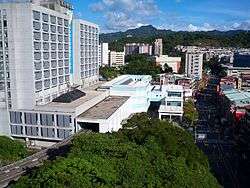 |
Wanfang Hospital | 萬芳醫院 | Wenshan | 99 | 25 | 1996-03-28 | |
| BR05 | Xinhai | 辛亥 | Wenshan | 106 | 25 | 1996-03-28 | ||
| BR06 | 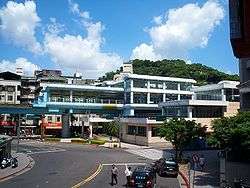 |
Linguang | 麟光 | Daan, Xinyi | 124 | 25 | 1996-03-28 | |
| BR07 | 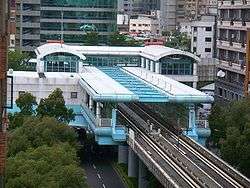 |
Liuzhangli | 六張犁 | Daan, Xinyi | 72 | 25 | 1996-03-28 | |
| BR08 | 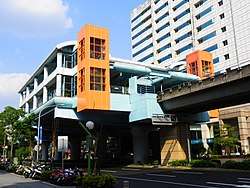 |
Technology Building | 科技大樓 | Daan | 122 | 25 | 1996-03-28 | |
| BR09 | Daan | 大安 | Daan | 69 | 30 | 1996-03-28 | Change for Tamsui–Xinyi line | |
| BR10 |  |
Zhongxiao Fuxing | 忠孝復興 | Daan | 67 | 45 | 1996-03-28 | Change for Bannan line |
| BR11 | 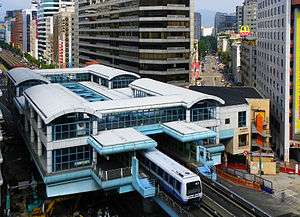 |
Nanjing Fuxing | 南京復興 | Zhongshan, Songshan | 86 | 30 | 1996-03-28 | Change for Songshan–Xindian line |
| BR12 | Zhongshan Junior High School | 中山國中 | Zhongshan, Songshan | 66 | 25 | 1996-03-28 | ||
| BR13 |  |
Songshan Airport | 松山機場 | Songshan | 142 | 25 | 2009-07-04 | Serves Songshan Airport |
| BR14 | Dazhi | 大直 | Zhongshan | 172 | 25 | 2009-07-04 | ||
| BR15 | Jiannan Road | 劍南路 | Zhongshan | 103 | 25 | 2009-07-04 | ||
| BR16 | 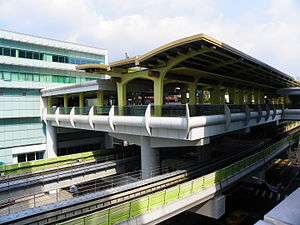 |
Xihu | 西湖 | Neihu | 110 | 25 | 2009-07-04 | |
| BR17 | Gangqian | 港墘 | Neihu | 65 | 25 | 2009-07-04 | ||
| BR18 |  |
Wende | 文德 | Neihu | 72 | 25 | 2009-07-04 | |
| BR19 | 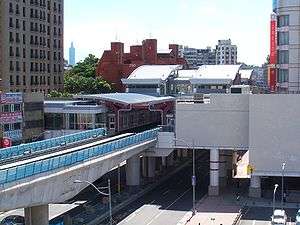 |
Neihu | 內湖 | Neihu | 78 | 25 | 2009-07-04 | |
| BR20 | 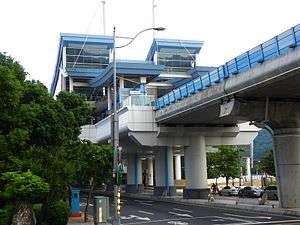 |
Dahu Park | 大湖公園 | Neihu | 71 | 25 | 2009-07-04 | |
| BR21 | 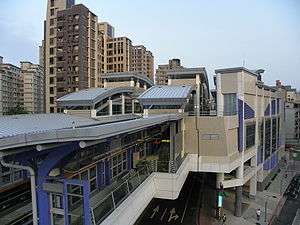 |
Huzhou | 葫洲 | Neihu | 121 | 25 | 2009-07-04 | |
| BR22 | 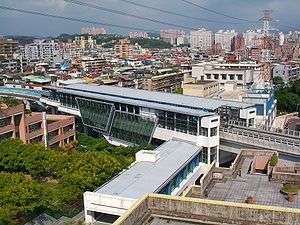 |
Donghu | 東湖 | Neihu | 78 | 25 | 2009-07-04 | |
| BR23 |  |
Nangang Software Park | 南港軟體園區 | Nangang | 85 | 25 | 2009-07-04 | |
| BR24 | 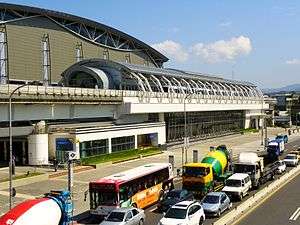 |
Taipei Nangang Exhibition Center | 南港展覽館 | Nangang | 78 | n/a | 2009-07-04 | Change for Bannan line |
References
- "Taipeï - en - Siemens".
- "Automated Metro - Taipei, Taiwan".
- 內湖線則採用膠輪/鋼軌系統,中心線間距為1,880mm。此外,文山線因採膠輪/水泥軌道系統,一般來說並無軌距之分,但其凸出於路面的兩條行車水泥軌枕,中心線間距為1,880mm。
- "None". Taipei Rapid Transit Corporation. 15 September 2011. Retrieved 15 November 2011.
- "Medium/High Capacity System Ridership Statistics". english.metro.taipei. 16 August 2011. Retrieved 16 April 2017.
- Prelypchan, Erin (4 December 1999). "Once again, MRT breaks down". Taipei Times. Retrieved 21 September 2019.
- Han Cheung (22 September 2019). "Taiwan in Time: The birth pangs of Taipei's MRT". Taipei Times. Retrieved 22 September 2019.
- High Court orders compensation in fight over MRT line, Joy Su, Taipei Times, 9 April 2004, p. 1
- Matra wins final appeal against city government, Rich Chang, 24 July 2005, Taipei Times, p. 1
- 木柵捷運馬特拉案 北市府認賠20億 每位市民賠790元, ETTV News, 17 August 2005
- 文湖線馬特拉舊車 今天檢核 (in Chinese). 自由時報. 19 December 2010. Retrieved 18 December 2010.
- "內湖捷運線採高架中運量系統".
- "捷運內湖線細說從頭". Department of Rapid Transit Systems. 1 September 2009. Retrieved 20 June 2010.
- "Route Map: 內湖線工程". East District Project Office, Department of Rapid Transit Systems. 11 June 2009. Archived from the original on 1 June 2009. Retrieved 13 July 2009.
- "內湖線松山機場站至劍南路站 電聯車運轉紀實". Department of Rapid Transit Systems. 1 June 2008. Retrieved 19 June 2010.
- Mo Yan-chih (11 July 2009). "MRT malfunction strands hundreds". Taipei Times. Retrieved 10 January 2016.
- "Wenhu line integrated for faster service". The China Post. 21 December 2010. Retrieved 21 December 2010.
- 文湖線馬特拉列車 26日上線 (in Chinese). The China Times. 22 December 2010. Retrieved 23 December 2010.
- "臺北捷運系統相鄰兩站間之行駛時間、停靠站時間 | 政府資料開放平臺". data.gov.tw (in Chinese). Retrieved 4 October 2019.